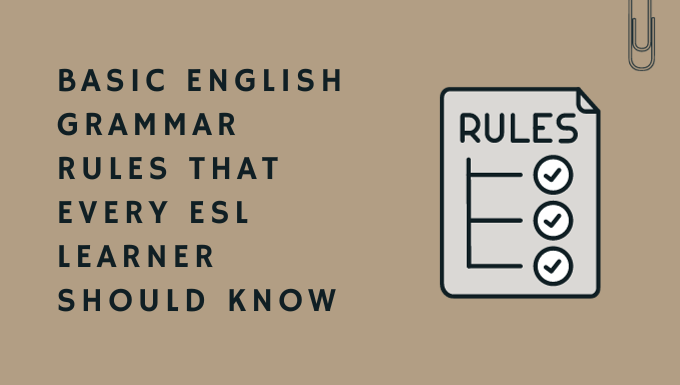
Hello, English learners! Today, we talk about some easy English grammar rules. Knowing these rules helps you speak and write English better.
Table of Contents
Essential English Grammar Rules
English grammar has rules that help us talk and write correctly and clearly. These rules are like tools that make it easier to learn and use English. When you know these rules, you can speak and write better. It’s good for school, work, and talking to people. Let’s look at some essential English grammar rules that are very helpful for everyone.
1. Match Subjects and Verbs
The first rule is to make sure the subject (who or what the sentence is about) and the verb (the action word) agree. If the subject is just one person or thing, use a verb for one. If the subject is more than one person or thing, use a verb for more than one.
Examples:
- One cat runs.
- Two cats run.
2. Using Past, Present, and Future
Verbs can tell when something happens. There are three times: past (already happened), present (happening now), and future (will happen).
Examples:
- Past: I walked yesterday.
- Present: I walk now.
- Future: I will walk tomorrow.
3. When to Use ‘A’, ‘An’, and ‘The’
We use ‘a’ and ‘an’ for things that are not specific. Use ‘a’ before words that start with a sound like ‘cat’. Use ‘an’ before words that start with a vowel sound like ‘apple’. Use ‘the’ for something specific.
Examples:
- A dog.
- An apple.
- The sun.
4. Where Things Are: Prepositions
Prepositions tell us where or when something is. Common prepositions are ‘in’, ‘on’, ‘at’, ‘by’, ‘for’, ‘with’.
Examples:
- In the morning.
- On the table.
- At school.
5. Using Pronouns
Pronouns are words like ‘he’, ‘she’, ‘it’, ‘they’. We use them instead of names or nouns to avoid repeating the same words.
Examples:
- Maria is here. She is on time.
- The dogs are barking. They are loud.
Is It Important to Study Basic English Grammar Rules?
Yes, it is very important to study Basic English Grammar Rules. It helps you speak and write English correctly. This makes it easier for others to understand you. Also, knowing grammar helps you learn more English in the future.
Conclusion
Remember, practice makes perfect. Keep using these rules when you talk or write in English. Soon, it will become easier. Happy learning!
English Grammar Rules FAQs
Here are some frequently asked questions (FAQs) about English grammar rules, tailored for learners at various stages:
1. What is the difference between ‘its’ and ‘it’s’?
Answer: ‘Its’ is a possessive form (meaning something belongs to ‘it’), while ‘it’s’ is a contraction for ‘it is’ or ‘it has’. Example: “The cat licked its fur” (possessive) vs. “It’s raining” (contraction for ‘it is’).
2. How do I use articles correctly?
Answer: Use ‘a’ before words that start with a consonant sound, and ‘an’ before words with a vowel sound. Use ‘the’ for specific things known to the reader. Example: “A dog”, “An apple”, “The sun we saw yesterday”.
3. What’s the difference between ‘there’, ‘their’, and ‘they’re’?
Answer: ‘There’ refers to a place, ‘their’ is a possessive form (meaning something belongs to ‘them’), and ‘they’re’ is a contraction of ‘they are’. Example: “They’re going to their house over there”.
4. How do I know when to use ‘who’ or ‘whom’?
Answer: Use ‘who’ as a subject (who does something) and ‘whom’ as an object (to whom something is done). Example: “Who wrote this?” vs. “To whom should I send this?”
5. When should I use ‘fewer’ and ‘less’?
Answer: Use ‘fewer’ for countable items and ‘less’ for uncountable or abstract quantities. Example: “Fewer apples”, “Less water”.
6. How do I use tenses correctly?
Answer: Match the verb tense to the time of action or state. Past tense for actions in the past, present tense for current actions, and future tense for actions that will happen. Example: “I walked”, “I walk”, “I will walk”.
7. What are modal verbs and how do I use them?
Answer: Modal verbs (like can, could, may, might, must, shall, should, will, would) express ability, possibility, permission, or obligation. They are used with the base form of a verb. Example: “She can swim”.
8. How do I form questions in English?
Answer: In most cases, invert the subject and the first auxiliary verb. If there’s no auxiliary verb, use do, does, or did. Example: “You are going” becomes “Are you going?” or “You went” becomes “Did you go?”
9. What is the Oxford comma and should I use it?
Answer: The Oxford comma is the comma used before the word ‘and’ at the end of a list. Its use depends on style guides or personal preference. Example: “I bought apples, bananas, and oranges” (with Oxford comma).
10. How do I choose between ‘which’ and ‘that’?
Answer: Use ‘that’ for essential clauses (without it, the sentence’s meaning changes) and ‘which’ for non-essential clauses (can be removed without changing the main meaning). Example: “The book that I borrowed was excellent” vs. “The book, which I borrowed from the library, was excellent.”
These FAQs cover basic and common English grammar queries, helping learners clarify frequent doubts and improve their language skills.